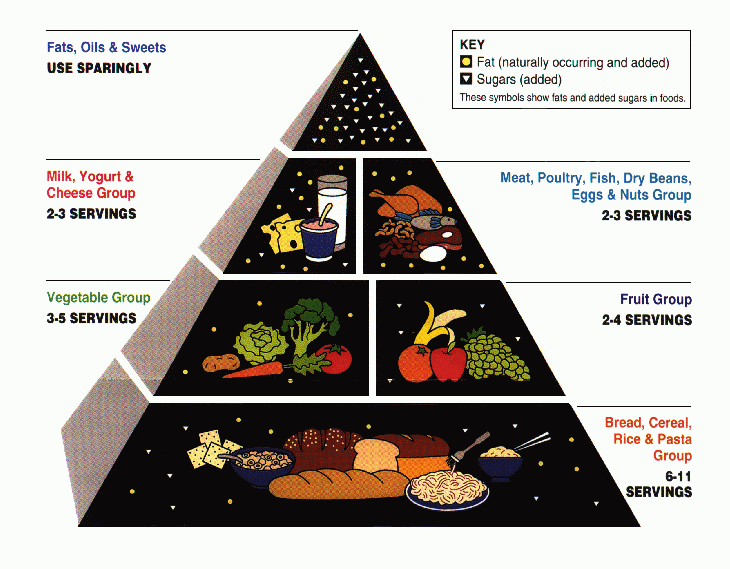What Happened to MyPyramid.gov?

on January 27, 2020
Since the 1980s, the United States Department of Agriculture (USDA) has been responsible for creating an information graphic known as the food pyramid. The pyramid is premised on the idea that for people to be healthy, they should follow a recommended way of eating. Even though the pyramid has been available for about four decades, it looks like the establishment of the website MyPyramid.gov on April 19, 2005, made the idea even more popular. However, any attempt to find the site today comes back with the message “www.mypyramid.gov’s server IP address could not be found.”
We took some time to find out what happened to MyPyramid.gov. The article ends by looking at current dietary guidelines and whether the idea of criticizing all types of fats is supported by scientific evidence.
The History of MyPyramid.gov

According to Laura Norén, writing for the website, TheSocietyPages.org, an open-access science project with headquarters at the University of Minnesota, the idea of the food pyramid can be traced back as far as the 1980s. The website reports that the graphic was not always a pyramid. Its evolution has been a product of the accumulation of new knowledge about what constitutes a proper diet.
In its early days, the food pyramid advised Americans to consume starch more than any other class of food. Unlike the recommendations available today, the pyramid did not seem to be concerned about the nutrition in foods. For instance, it recommended the eating of all grains. This does not seem to take into account the idea that there are whole grains, which are healthier, and processed grains, which are not as nutritious (Source).
Even though the earlier pyramid contained some useful advice like recommending the consumption of fruits and vegetables, it still had a category that included foods high in sugar. Why did the pyramid not explicitly indicate that these foods are dangerous? Norén attempts to provide an answer: “Promoters of those particular food commodities don’t want the government telling people that ice cream is bad for us. They’d prefer that it be eaten sparingly” (Source).
The 1992 Pyramid
The USDA introduced one of the most famous pyramids in 1992. According to Emily Stephenson, writing for the news agency Reuters, the stacking of foods by suggested servings, which this pyramid suggested, was generally criticized. She notes that nutritional experts argued that the pyramid recommended the eating of too many grains (Source).
Introducing MyPyramid.gov

To deal with the criticism leveled against the 1992 food pyramid, the USDA introduced an updated version called MyPyramid in 2005. This update came with a website: MyPyramid.gov. The new site was included as a resource to explain why each of the five food groups is important. It also recommended the amount of each type of food each individual should eat every day (Source).
MyPyramid Replaced By MyPlate

In 2011, MyPyramid was replaced by MyPlate. When a circular icon replaced the triangular pyramid, some writers like Marion Nestle, writing for the health section of The Atlantic, were quick to show their disdain for the old pyramid. Nestle writes: "On May 26, the US Department of Agriculture announced that it would be releasing a new 'food icon' to replace the foodless and useless 2005 MyPyramid” (Source).
MyPlate advised Americans to ensure that half of the food they eat should consist of fruits and vegetables. Explaining why the new recommendations were called MyPlate, the then US first lady, Michelle Obama, is quoted by Reuters saying, "When it comes to eating, what's more useful than a plate? What's more simple than a plate?" She adds: “This is a quick, simple reminder for all of us to be more mindful of the foods that we’re eating” (Source).
What then Happened to MyPyramid.gov?
Health professionals had often complained that the MyPyramid was too complicated to teach and understand. Hence, MyPlate eventually replaced MyPyramid. However, there is little information about what happened to MyPyramid.gov. It looks like the site was discarded together with the triangular icon.
Current Dietary Guidelines
From the history of the food pyramid, it is clear that when it comes to dietary recommendations, nothing is cast in stone. This is possibly the reason why the USDA updates its recommendations every five years.
Below is a summary of the recommendations contained in the current guidelines: USDA’s Dietary Guidelines for Americans 2015-2020.

Healthy eating pattern: It is vital to be conscious about everything you eat. This includes being mindful of the number of calories you consume against those you need to maintain a healthy weight.
Nutrient density: Restricting calories should be accompanied by selecting a variety of foods that are nutrient-dense and ensure consumption is according to recommended amounts.
Avoid saturated fats and added sugars: Be clear about foods that have added sugars and those containing saturated fats and sodium. Know the recommended levels for such foods and follow them.
Chose healthier beverages: Choose beverages that are nutrient-dense and avoid those with added sugar. Drink adequate amounts of water.

Physical activity: Incorporate the recommended amount of physical activity per day into your routine to support your healthy eating patterns.

Questioning the USDA recommendations
The integrity of the USDA guidelines has sometimes been challenged. For instance, an article written by Terrence Kealey and published by the policy research organization Cato Institute, reports that after the release of the latest recommendations in 2015, “Congress, citing concerns over scientific integrity, commissioned the National Academy of Medicine to review the process of generating those guidelines” (Source).
According to Kealey, one of the main issues that Congress was concerned about was the dietary recommendations’ “long-standing demonization of fats and its praise for carbohydrates." The feeling was that this was suspect. Questioning this specific aspect of the recommendations was a boost for organizations that have advocated for diets that are high in unsaturated fats, like the ketogenic diet. The ketogenic diet recommends an increase in the consumption of unsaturated fats. These fats are found in avocados, olive oil, peanut butter, nuts, and fatty fish (Source).














